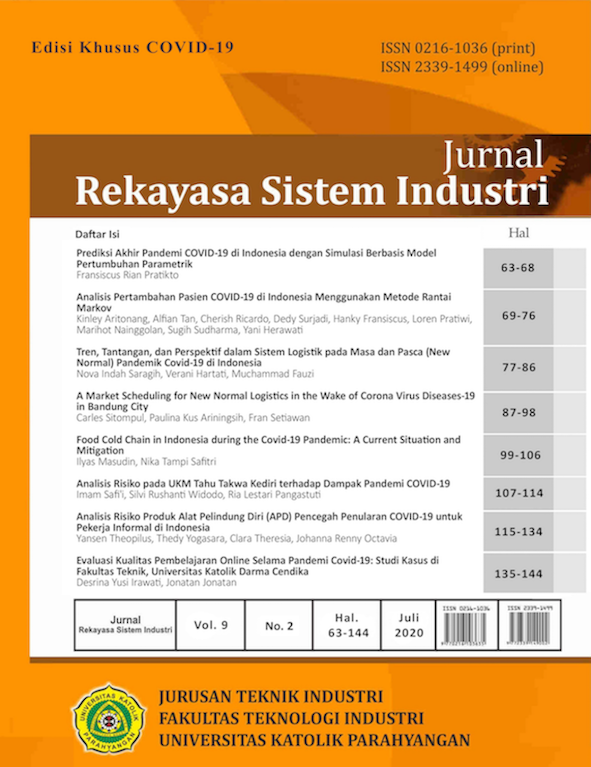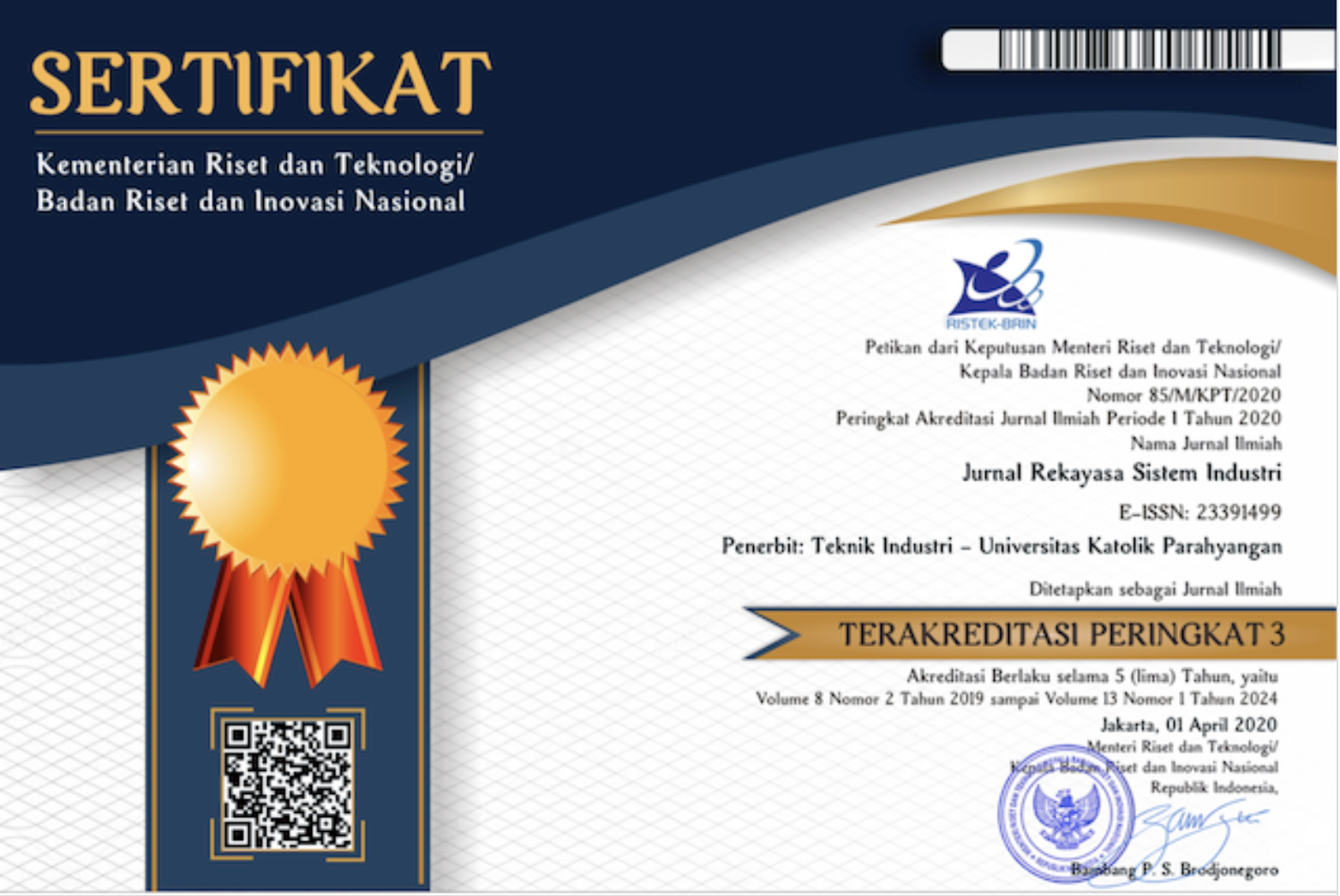Food Cold Chain in Indonesia during the Covid-19 Pandemic: A Current Situation and Mitigation
DOI:
https://doi.org/10.26593/jrsi.v9i2.3981.99-106Abstrak
The spread of the corona virus (COVID-19) has had a massive impact on all business sectors in Indonesia. Food cold supply chain is a business sector that is quite badly affected. This is because the food cold chain requires special treatment to maintain its quality, has a relatively short life and cannot be returned. This article discusses the impact of the COVID-19 pandemic and its social impacts such as social restrictions and area lockdown on the business of food cold chain. It also discusses mitigation that needs to be done to anticipate related issues such as food supply-demand, food safety and some transportation challengesReferensi
Acikel, C. H., Ogur, R., Yaren, H., Gocgeldi, E., Ucar, M., & Kir, T. (2008). The hygiene training of food handlers at a teaching hospital. Food control, 19(2), 186-190.
Agency, S. C. A. I. (2020). Cyber Security Guide Security Risk Management in the Middle of Covid-19 Pandemic.
Aguglia, L., De Santis, F., & Salvioni, C. (2009). Direct selling: a marketing strategy to shorten distances between production and consumption.
BPS. (2018). Statistics Indonesia. Retrieved from https://www.bps.go.id/.
Capricorn Indonesia Consult, P. (2019). A Cold Chain Study of Indonesia. In E. Kusano (Ed.), The Cold Chain for Agri-food Products in ASEAN (ERIA Research Project Report FY2018 ed., pp. 101-147). Jakarta.
Chae, B. K. (2009). Developing key performance indicators for supply chain: an industry perspective. Supply Chain Management: An International Journal.
Cowling, B., Zhou, Y., Ip, D., Leung, G., & Aiello, A. (2010). Face masks to prevent transmission of influenza virus: a systematic review. Epidemiology & Infection, 138(4), 449-456.
Eisya, E. A. (2020). Logistics down by more than 50 percent amid COVID-19 outbreak. The Jakarta Post.
Galanakis, C. M. (2020). The Food Systems in the Era of the Coronavirus (COVID-19) Pandemic Crisis. Foods, 9(4), 523.
Hobbs, J. E. (2020). Food supply chains during the COVID‐19 pandemic. Canadian Journal of Agricultural Economics/Revue canadienne d'agroeconomie.
Kesavan, S., Kushwaha, T., & Gaur, V. (2016). Do high and low inventory turnover retailers respond differently to demand shocks? Manufacturing & Service Operations Management, 18(2), 198-215.
King, R. P., & Venturini, L. (2005). Demand for quality drives changes in food supply chains. New directions in global food markets, 794.
Li, J., & Chan, F. T. (2012). The impact of collaborative transportation management on demand disruption of manufacturing supply chains. International Journal of Production Research, 50(19), 5635-5650.
Richards, G. (2001). Enteric virus contamination of foods through industrial practices: a primer on intervention strategies. Journal of Industrial Microbiology and Biotechnology, 27(2), 117-125.
Rzeżutka, A., & Cook, N. (2004). Survival of human enteric viruses in the environment and food. FEMS microbiology reviews, 28(4), 441-453.
Saulo, A. A. (2012). Reusable Grocery Bags and Norovirus Transmission.
Seymour, I., & Appleton, H. (2001). Foodborne viruses and fresh produce. Journal of applied microbiology, 91(5), 759-773.
Simatupang, T. M., & Sridharan, R. (2005). An integrative framework for supply chain collaboration. The International Journal of Logistics Management.
Sinclair, R., Fahnestock, L., Linda, L., & Perry, C. (2018). The spread of a norovirus surrogate via reusable grocery bags in a grocery supermarket.
Tobing, B. (2015). Food Supply Chain. Supply Chain Indonesia. Retrieved from https://supplychainindonesia.com/wp-content/files/Rantai_Pasok_Pangan1.pdf website
Trkman, P., McCormack, K., De Oliveira, M. P. V., & Ladeira, M. B. (2010). The impact of business analytics on supply chain performance. Decision Support Systems, 49(3), 318-327.
Tsironi, T., Giannoglou, M., Platakou, E., & Taoukis, P. (2015). Training of SMEs for frozen food shelf life testing and novel smart packaging application for cold chain monitoring. International Journal of Food Studies, 4(2).
WHO. (2020). COVID-19 and food fafety: guidance for food businesses: interim guidance, 07 April 2020: World Health Organization.
Yang, D., Qi, E., & Li, Y. (2015). Quick response and supply chain structure with strategic consumers. Omega, 52, 1-14.
Ziska, L., Crimmins, A., Auclair, A., DeGrasse, S., Garofalo, J. F., Khan, A. S., . . . Walls, I. (2016). Ch. 7: Food Safety, Nutrition, and Distribution The Impacts of Climate Change on Human Health in the United States: A Scientific Assessment (pp. 189–216). Washington, DC: U.S. Global Change Research Program.













